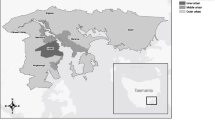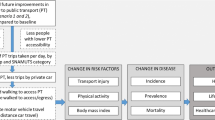Abstract
Transport systems can play an important role in increasing physical activity (PA). Bogotá has been recognized for its bus rapid transit (BRT) system, TransMilenio (TM). To date, BRTs have been implemented in over 160 cities worldwide. The aim of this study was to assess the association between PA and the use of TM among adults in Bogotá. The study consists of a cross-sectional study conducted from 2010 to 2011 with 1000 adults. PA was measured using the International Physical Activity Questionnaire. In a subsample of 250 adults, PA was objectively measured using ActiGraph accelerometers. Analyses were conducted using multilevel logistic regression models. The use of TM was associated with meeting moderate-to-vigorous PA (MVPA). TM users were more likely to complete an average of >22 min a day of MVPA (odds ratio [OR] = 3.1, confidence interval [CI] = 95 % 1.4–7.1) and to walk for transportation for ≥150 min per week (OR = 1.5; CI = 95 % 1.1–2.0). The use of TM was associated with 12 or more minutes of MVPA (95 % CI 4.5–19.4, p < 0.0001). Associations between meeting PA recommendations and use of TM did not differ by socioeconomic status (p value = 0.106) or sex (p value = 0.288). The use of TM is a promising strategy for enhancing public health efforts to reduce physical inactivity through walking for transport. Given the expansion of BRTs, these results could inform the development of transport PA programs in low- to high-income countries.


Similar content being viewed by others
References
Lee I-M, Shiroma EJ, Lobelo F, Puska P, Blair SN, Katzmarzyk PT, et al. Effect of physical inactivity on major non-communicable diseases worldwide: an analysis of burden of disease and life expectancy. Lancet. 2012; 380: 219–229.
WHO WH. WHO | 2008–2013 Action plan for the global strategy for the prevention and control of noncommunicable diseases [Internet] 2008 [cited 2014 Aug 8]. Available from: http://www.who.int/nmh/publications/ncd_action_plan_en.pdf. Accessed 20 June 2014.
Kahlmeier S, Racioppi F, Cavill N, Rutter H, Oja P. “Health in all policies” in practice: guidance and tools to quantifying the health effects of cycling and walking. J Phys Act Health. 2010; 7(Suppl 1): S120–S125.
Hamer M, Chida Y. Active commuting and cardiovascular risk: a meta-analytic review. Prev Med. 2008; 46: 9–13.
Gordon-Larsen P, Boone-Heinonen J, Sidney S, Sternfeld B, Jacobs DR, Lewis CE. Active commuting and cardiovascular disease risk: the CARDIA study. Arch Intern Med. 2009; 169: 1216–1223.
Freeland AL, Banerjee SN, Dannenberg AL, Wendel AM. Walking associated with public transit: moving toward increased physical activity in the United States. Am J Public Health. 2013; 103: 536–542.
Sugiyama T, Neuhaus M, Cole R, Giles-Corti B, Owen N. Destination and route attributes associated with adults’ walking: a review. Med Sci Sports Exerc. 2012; 44: 1275–1286.
Ewing R, Cervero R. Travel and the built environment. J Am Plan Assoc. 2010; 76: 265–294.
Hino AAF, Reis RS, Sarmiento OL, Parra DC, Brownson RC. The built environment and recreational physical activity among adults in Curitiba, Brazil. Prev Med. 2011; 52: 419–422.
Cervero R, Sarmiento OL, Jacoby E, Gomez LF, Neiman A. Influences of built environments on walking and cycling: lessons from Bogotá. Int J Sustain Transp. 2009; 3: 203–226.
Gomez LF, Sarmiento OL, Parra DC, Schmid TL, Pratt M, Jacoby E, et al. Characteristics of the built environment associated with leisure-time physical activity among adults in Bogotá, Colombia: a multilevel study. J Phys Act Health. 2010; 7(Suppl 2): S196–S203.
Wener RE, Evans GW. A morning stroll: levels of physical activity in car and mass transit commuting. Environ. Behav. [Internet]. 2007 [cited 2014 Aug 8];39. Available from: http://trid.trb.org/view.aspx?id=815248. Accessed 23 June 2014.
Lachapelle U, Frank LD. Transit and health: mode of transport, employer-sponsored public transit pass programs, and physical activity. J Public Health Policy. 2009; 30(Suppl 1): S73–S94.
Ding D, Adams MA, Sallis JF, Norman GJ, Hovell MF, Chambers CD, et al. Perceived neighborhood environment and physical activity in 11 countries: do associations differ by country? Int J Behav Nutr Phys Act. 2013; 10: 57.
EMBARQ. Globar BRT data [Internet]. 2013 [cited 2014 Aug 8]. Available from: http://www.brtdata.org/#/location. Accessed 18 June 2014.
Hidalgo D, Gutiérrez L. BRT and BHLS around the world: explosive growth, large positive impacts and many issues outstanding. Res Transp Econ. 2013; 39: 8–13.
Gwilliam K. Cities on the move [Internet]. The World Bank; 2002 [cited 2014 Aug 8]. Available from: http://elibrary.worldbank.org/doi/book/10.1596/0-8213-5148-6. Accessed 14 July 2014.
Institute for Transportation and Development policy. The life and death of urban highways [Internet]. ITDP; 2012. Available from: http://www.itdp.org/library/publications/the-life-and-death-of-urban-highways/. Accessed 12 May 2014.
Consejo Nacional de Política Económica y Social. Documento CONPES 3093, Sistema de Servicio Público Urbano de Transporte Masivo de Pasajeros de Bogotá – Seguimiento –. 2000 [Internet]. 2000. Available from: https://www.dnp.gov.co/LinkClick.aspx?fileticket=VHPsmMeAtDU%3D&tabid=1063. Accessed 23 June 2014.
Hidalgo D, Pereira L, Estupiñán N, Jiménez PL. TransMilenio BRT system in Bogota, high performance and positive impact—main results of an ex-post evaluation. Res Transp Econ. 2013; 39: 133–138.
Rodríguez DA, Brisson EM, Estupiñán N. The relationship between segment-level built environment attributes and pedestrian activity around Bogota’s BRT stations. Transp Res Part Transp Environ. 2009; 14: 470–478.
Alcaldía Mayor de Bogotá. Aprobado cupo de endeudamiento para Bogotá | Portal Bogota | Bogota.gov.co [Internet]. 2013 [cited 2014 Aug 8]. Available from: http://www.bogota.gov.co/content/aprobado-cupo-de-endeudamiento-para-bogot%C3%A1. Accessed 8 July 2014.
DANE. Proyecciones de población [Internet]. 2013 [cited 2014 Aug 8]. Available from: https://www.dane.gov.co/index.php/poblacion-y-demografia/proyecciones-de-poblacion. Accessed 5 May 2014.
Unión Temporal Steer Davies - Centro Nacional de Consultoría. Informe de indicadores, Encuesta de Movilidad de Bogotá 2011. Bogotá: Unión Temporal Steer Davies - Centro Nacional de Consultoría; 2012.
Kerr J, Sallis JF, Owen N, De Bourdeaudhuij I, Cerin E, Sugiyama T, et al. Advancing science and policy through a coordinated international study of physical activity and built environments: IPEN adult methods. J Phys Act Health. 2013; 10: 581–601.
IPAQ [Internet]. Int. Phys. Act. Quest. 2002 [cited 2014 Aug 11]. Available from: http://www.ipaq.ki.se/ipaq.htm. Accessed 10 June 2014.
Hallal PC, Gomez LF, Parra DC, Lobelo F, Mosquera J, Florindo AA, et al. Lessons learned after 10 years of IPAQ use in Brazil and Colombia. J Phys Act Health. 2010; 7(Suppl 2): S259–S264.
Freedson PS, Melanson E, Sirard J. Calibration of the Computer Science and Applications Inc. accelerometer. Med Sci Sports Exerc. 1998; 30: 777–781.
Hearst MO, Sirard JR, Forsyth A, Parker ED, Klein EG, Green CG, et al. The relationship of area-level sociodemographic characteristics, household composition and individual-level socioeconomic status on walking behavior among adults. Transp Res Part Policy Pract. 2013; 50: 149–157.
Frank LD, Sallis JF, Saelens BE, Leary L, Cain K, Conway TL, et al. The development of a walkability index: application to the Neighborhood Quality of Life Study. Br J Sports Med. 2010; 44: 924–933.
Wood S. Generalized Additive Models: An Introduction with R. 1st ed. Boca Raton, FL: Chapman and Hall/CRC; 2006.
Day K, Loh L, Ruff RR, Rosenblum R, Fischer S, Lee KK. Does bus rapid transit promote walking? An examination of New York City’s select bus service. J Phys Act Health. 2014; 11: 1512–1516.
Daniels R, Mulley C. Explaining walking distance to public transport: the dominance of public transport supply. J Transp Land Use. 2013; 6: 5–20.
Hino AAF, Reis RS, Sarmiento OL, Parra DC, Brownson RC. Built environment and physical activity for transportation in adults from Curitiba, Brazil. J Urban Health. 2014; 91: 446–462.
Saelens BE, Vernez Moudon A, Kang B, Hurvitz PM, Zhou C. Relation between higher physical activity and public transit use. Am J Public Health. 2014; 104: 854–859.
Pratt M, Macera CA, Wang G. Higher direct medical costs associated with physical inactivity. Phys Sportsmed. 2000; 28: 63–70.
Montes F, Sarmiento OL, Zarama R, Pratt M, Wang G, Jacoby E, et al. Do health benefits outweigh the costs of mass recreational programs? An economic analysis of four Ciclovía programs. J Urban Health Bull N Y Acad Med. 2012; 89: 153–70.
ᅟ
ᅟ
ᅟ
ᅟ
Acknowledgments
The authors of the research would like to acknowledge El Centro Nacional de Consultoría (Bogotá, Colombia) for its collaboration in data collection and Andrea Ramirez for valuable comments.
The study was funded by the Center for Interdisciplinary Studies in Basic and Applied Complexity (CeiBA), Bogotá, Colombia, Colciencias grant 519 2010, Fogarty, and a grant from the sustainable mobility research projects at the U'niversidad de los Andes in Bogotá. The “Programa nacional de formación doctoral Francisco Jose de Caldas” from Colciencias (Convocatorias 511-2010 and 567-2012) funded the work of Jose D. Meisel and Pablo D. Lemoine.
Author information
Authors and Affiliations
Corresponding author
Ethics declarations
All of the protocols and questionnaires were reviewed and approved by the Institutional Review Board of the Universidad de los Andes in Bogotá.
Rights and permissions
About this article
Cite this article
Lemoine, P.D., Sarmiento, O.L., Pinzón, J.D. et al. TransMilenio, a Scalable Bus Rapid Transit System for Promoting Physical Activity. J Urban Health 93, 256–270 (2016). https://doi.org/10.1007/s11524-015-0019-4
Published:
Issue Date:
DOI: https://doi.org/10.1007/s11524-015-0019-4




